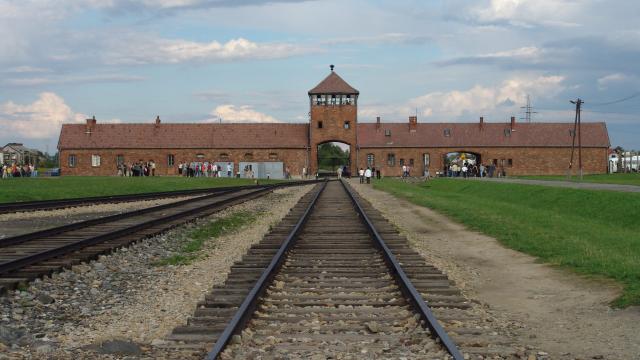In 1944, Marcel Nadjari — a Greek Jew who was forced to remove bodies from the Auschwitz gas chambers — buried a letter in a forest near the camp. The text was rediscovered in 1980, but it was virtually unreadable. Using a new imaging technique, scientists have finally reconstructed the letter, and it’s providing harrowing new details of the Holocaust — and what it was like to work as a forced labourer in a Nazi extermination camp.
Photo: Michel Zacharz AKA Grippenn via Wikimedia Commons
As reported in Deutsche Welle and Spiegel, a restoration effort headed by Russian-born historian Pavel Polian has brought the handwritten text of a document buried by Auschwitz-Birkenau prisoner Marcel Nadjari back to life. The letter, enclosed in a thermos and wrapped in a leather binding, was buried by Nadjari in November 1944 just outside the extermination camp, where it lay buried for 36 years. It was accidentally unearthed by a student in 1980, but most of the text was unlegible. Using a technique called multispectral analysis, Polian, with the help of Russian IT expert Aleksandr Nikitjaev, managed to decipher upwards of 90 per cent of the document. The details of this work are set to be published by the Munich-based Institute of Contemporary History (IfZ) in November.
Nadjari, a Jew from Thessaloniki, Greece, had the misfortune of working as a member of the Auschwitz-Birkenau Sonderkommando. These forced labourers had to perform the unthinkable, removing the bodies from the gas chambers, extracting teeth, shaving off their hair (which was processed into yarn), delivering the bodies to the crematorium, and disposing the ashes into rivers. Members of the Sonderkommando were frequently killed and replaced with new arrivals; out of the estimated 2200 Jews assigned for this task, only a few hundred managed to survive the war.
Nadjari’s secret note represents one of nine similar records written by five Sonderkommando members, though his is the only one written in Greek (the others being in Yiddish). Only 10 to 15 per cent of the surviving document was originally legible. Nikitjaev was able to read the badly smudged text by taking multi-spectral recordings of the document at various optical wavelengths. This non-invasive technique allows researchers to map and identify the pigments (in this case ink) on badly worn documents and visualise the reflections that characterise a letter. Working for an entire year, Nikitjaev progressed through the document, turning the blurred script into outlines of letters that could be made visible again.
Nadjari had written the letter in the hopes that whoever found it would deliver the document to a diplomatic representative of Greece, who would subsequently hand it over to either friends or family back home. Reading the recovered text, it’s clear that Nikitjaev was distraught by the nature of his work, and even contemplated suicide. But it was his thoughts of vengeance that kept him going.
“When you read what work I did, you will say, how could I… or anyone else do this work and burn his fellow believers… many times I thought of coming in with them [into the gas chambers] to finish, but I have always kept my revenge: I wanted to live to avenge the death of Papa and Mama, and that of my beloved little sister, Nelli,” wrote Nadjari in the restored document.

Image: Pavel Polian
His accounts of life as a member of the Sonderkommando are particularly harrowing.
“Our work was to receive them first, most of them did not know the reason… the people I saw when their destiny was sealed, I told the truth, and after they were all naked, they went further into the death chamber, where the Germans had laid pipes on the ceiling to make them think they were preparing the bath, with whips in their hands, the Germans forced them to move closer and closer together, so that as many as possible could fit in, a true Sardinian death, then the doors were hermetically sealed,” wrote Nadjari. “After half an hour, we opened the doors [of the gas chamber], and our work began. We carried the corpses of these innocent women and children to the elevator, which brought them into the room with the ovens, and they put them in there the furnaces, where they were burnt without the use of fuel, because of the fat they have.”
He also participated in the spreading of the ashes, which the Nazis did to cover their tracks. Nadjari figured that his days were numbered and that he’d eventually be killed in the gas chambers. “We have to leave the earth because we know so much,” he wrote.
Nadjari managed to survive his experience at Auschwitz-Birkenau, where around 1.1 million people, the vast majority of them Jews, were killed during the Second World War. He returned to Greece after the war, and eventually moved to the United States. Nadjari died at the age of 54 in New York, before his document was rediscovered.
[Institute of Contemporary History — Munich, Berlin (IfZ) via Deutsche Welle and Spiegel]
